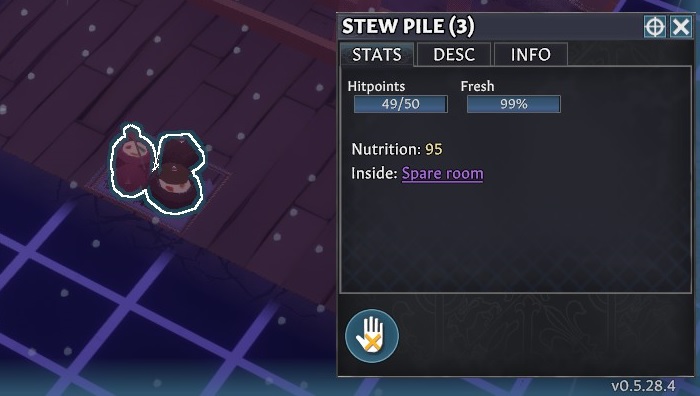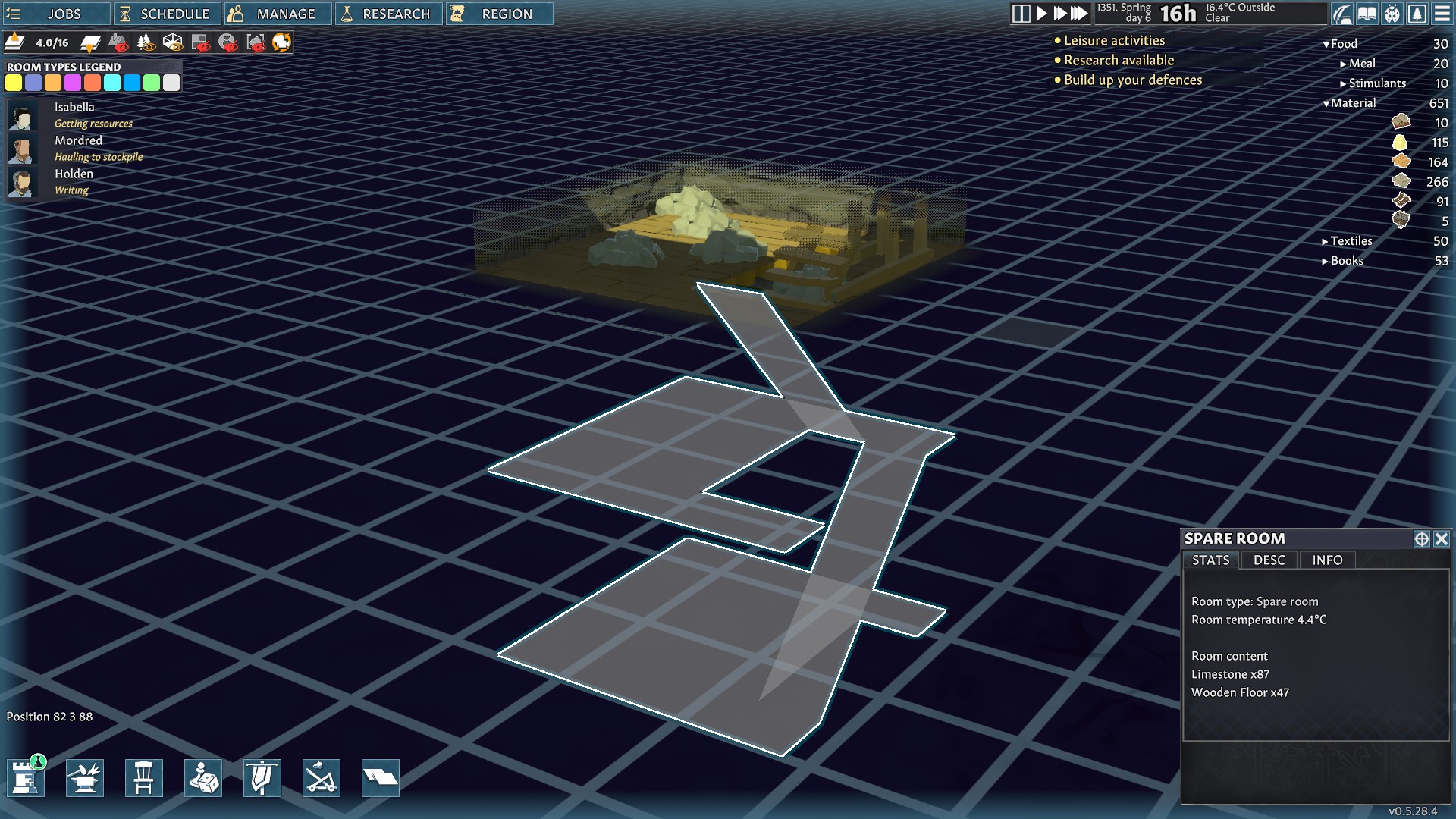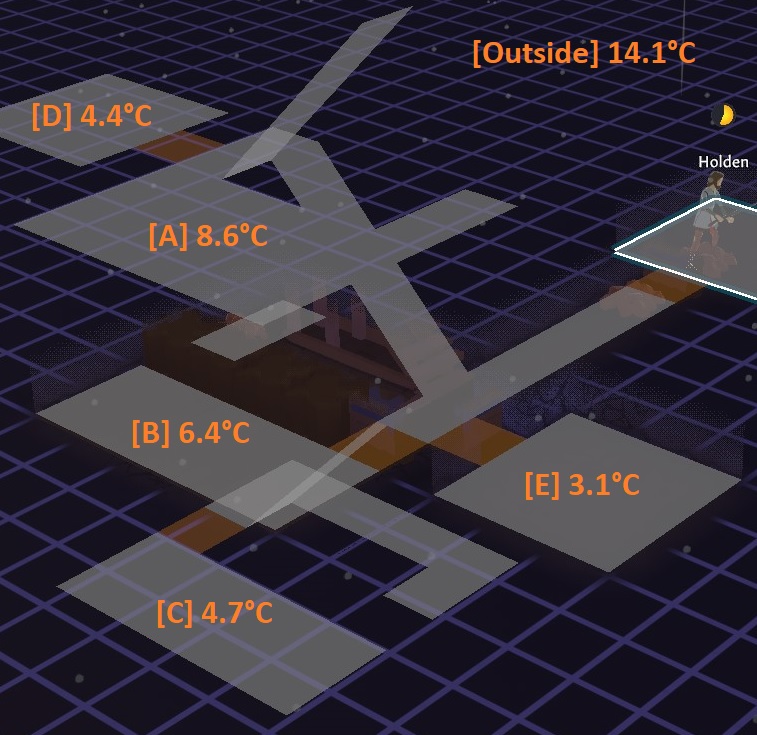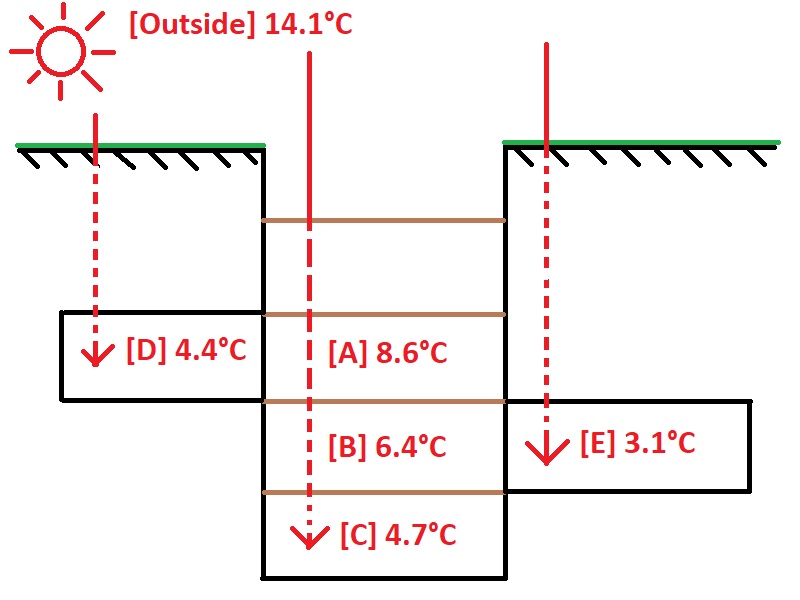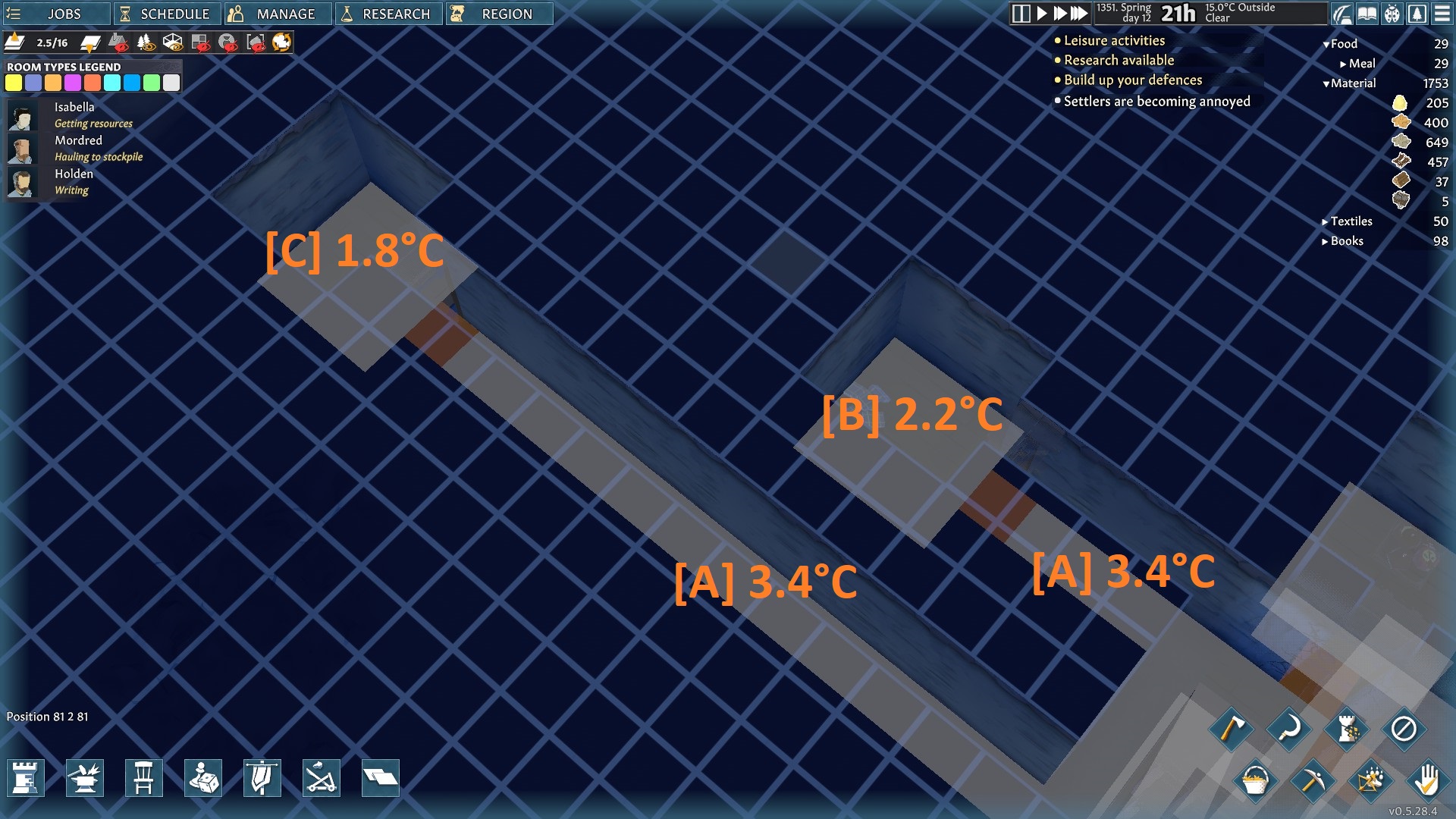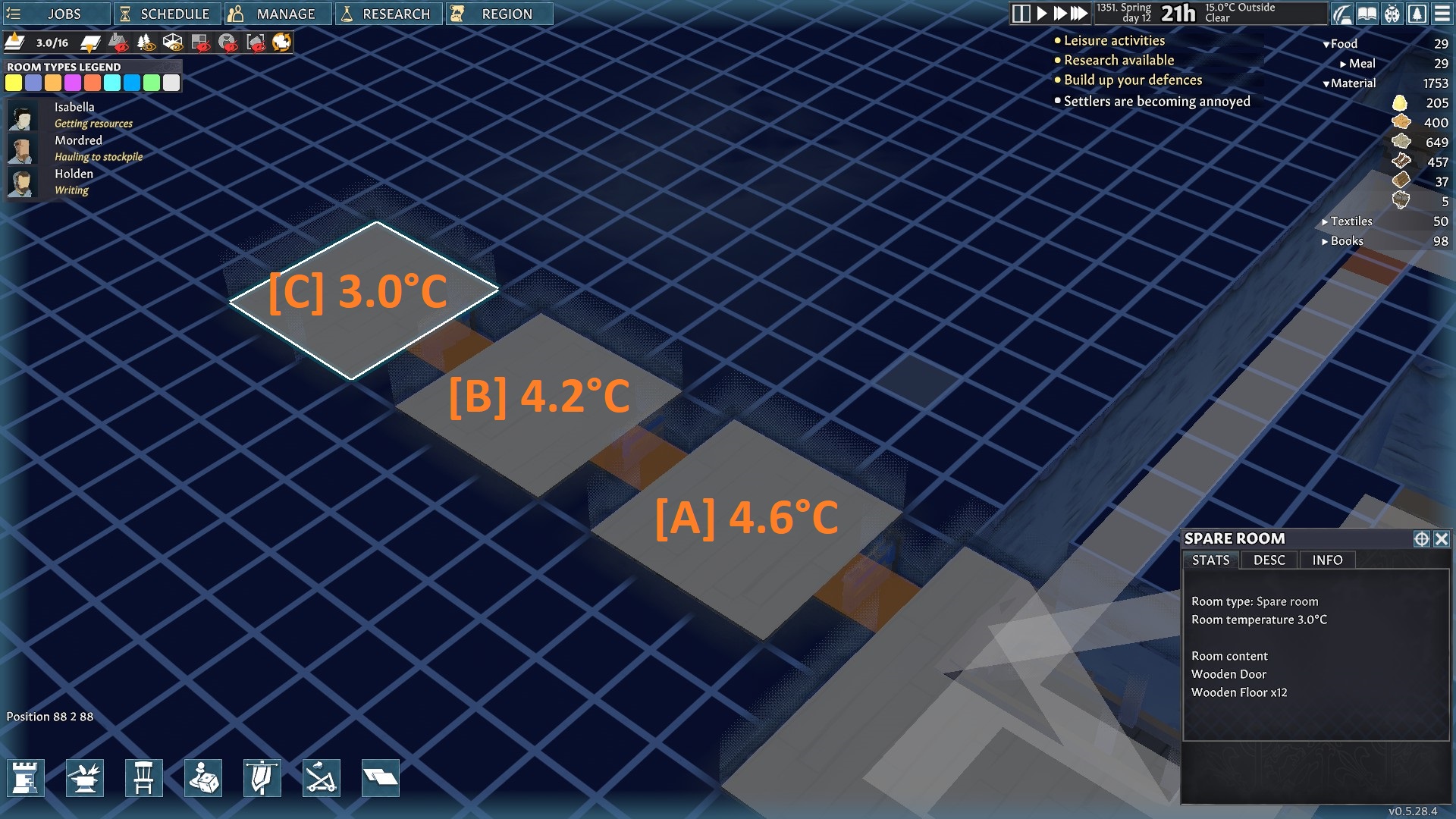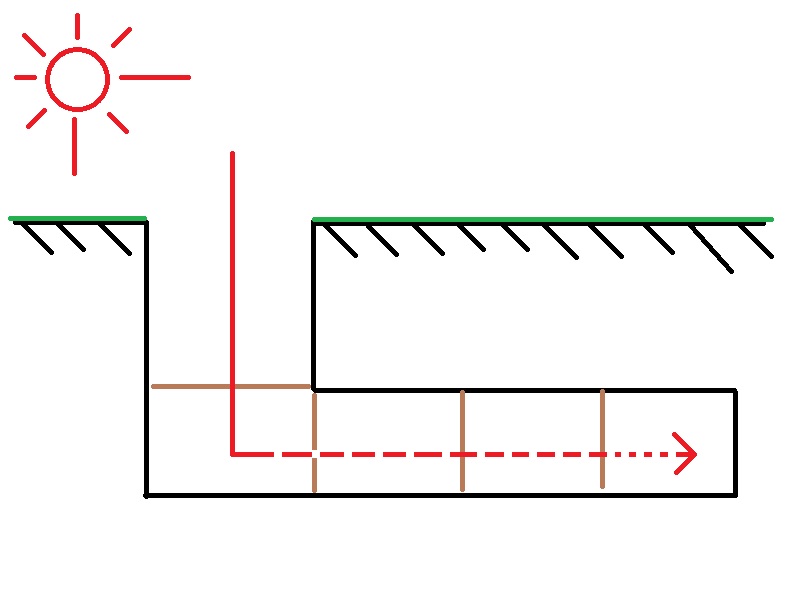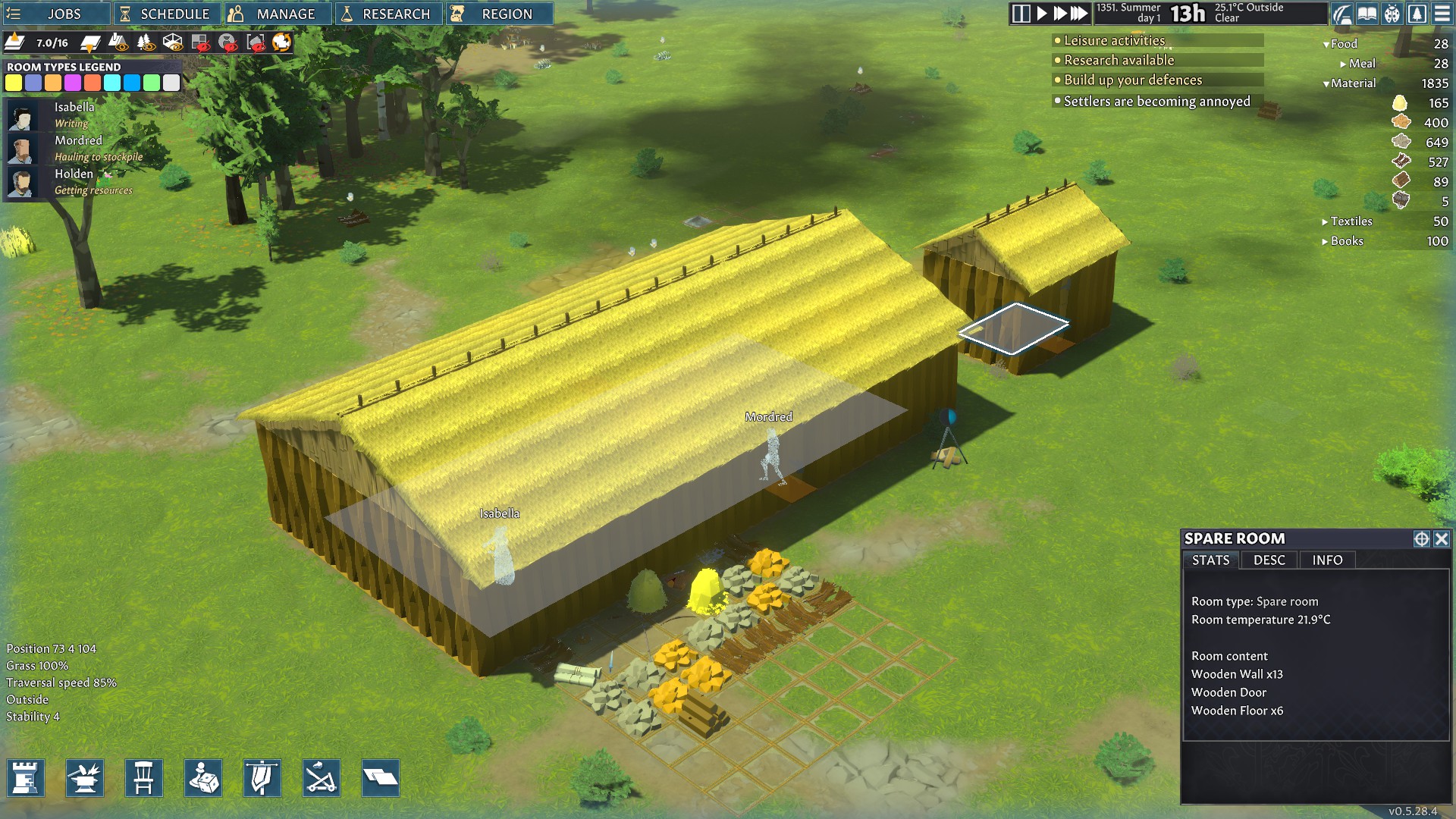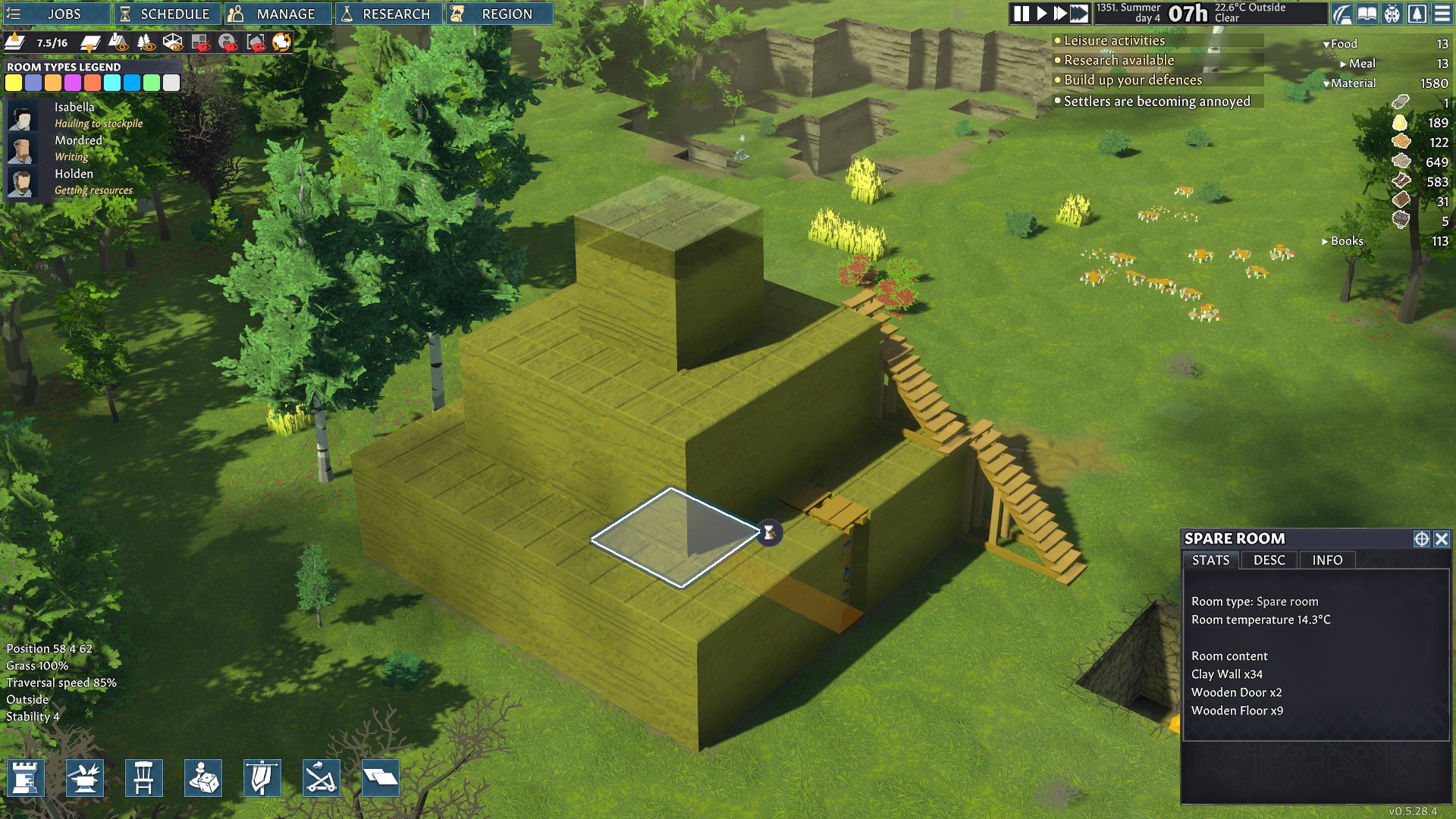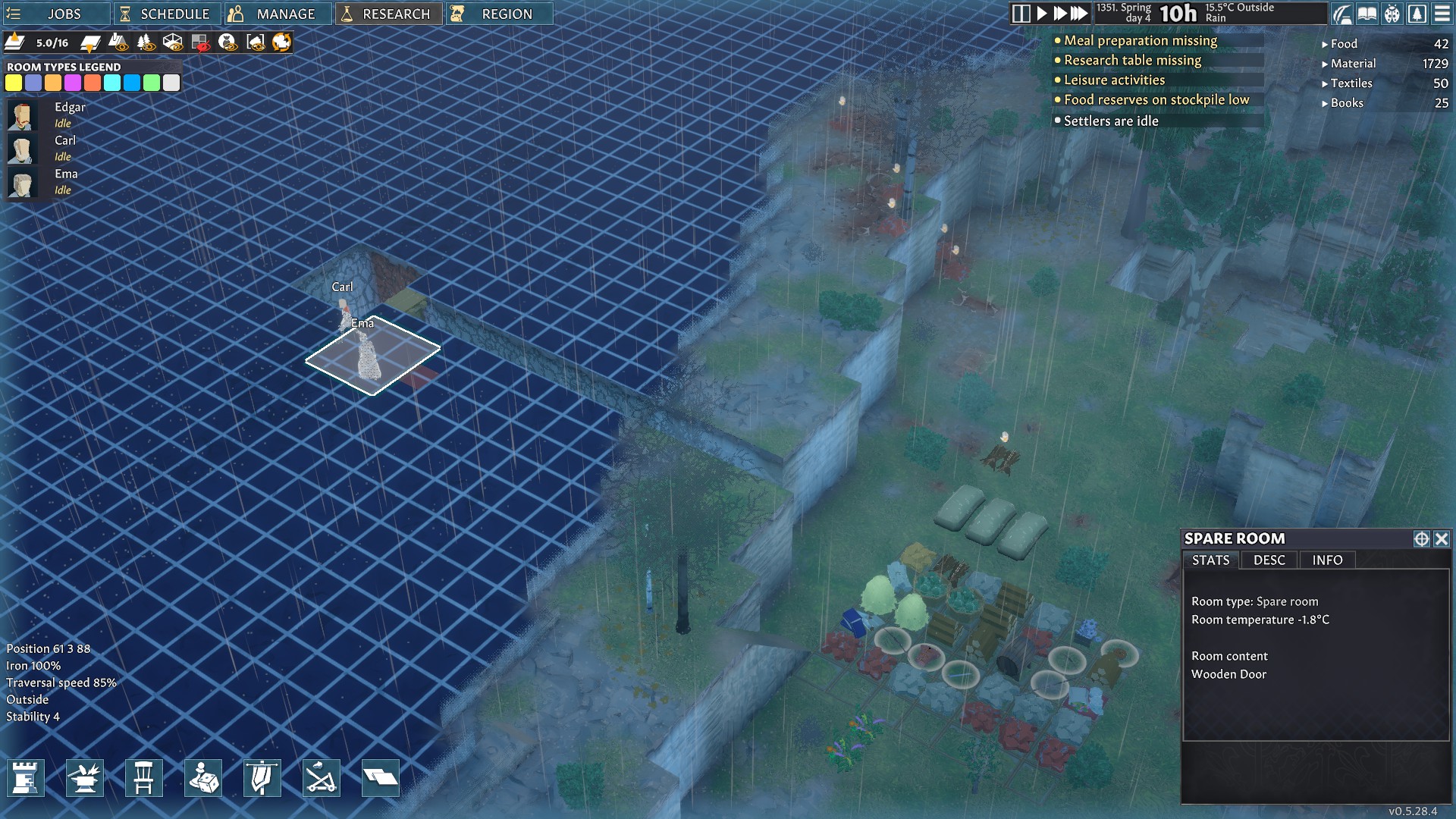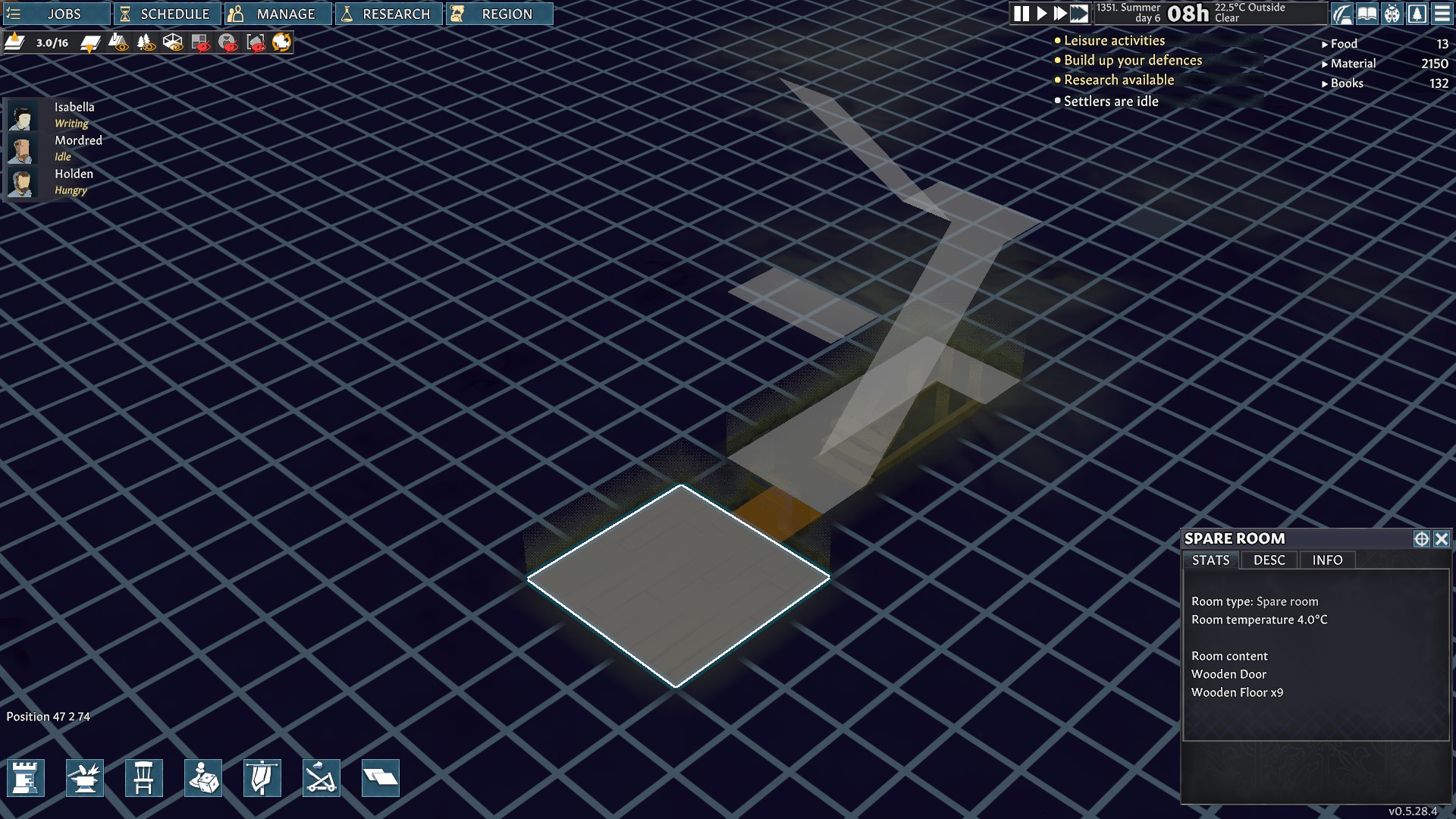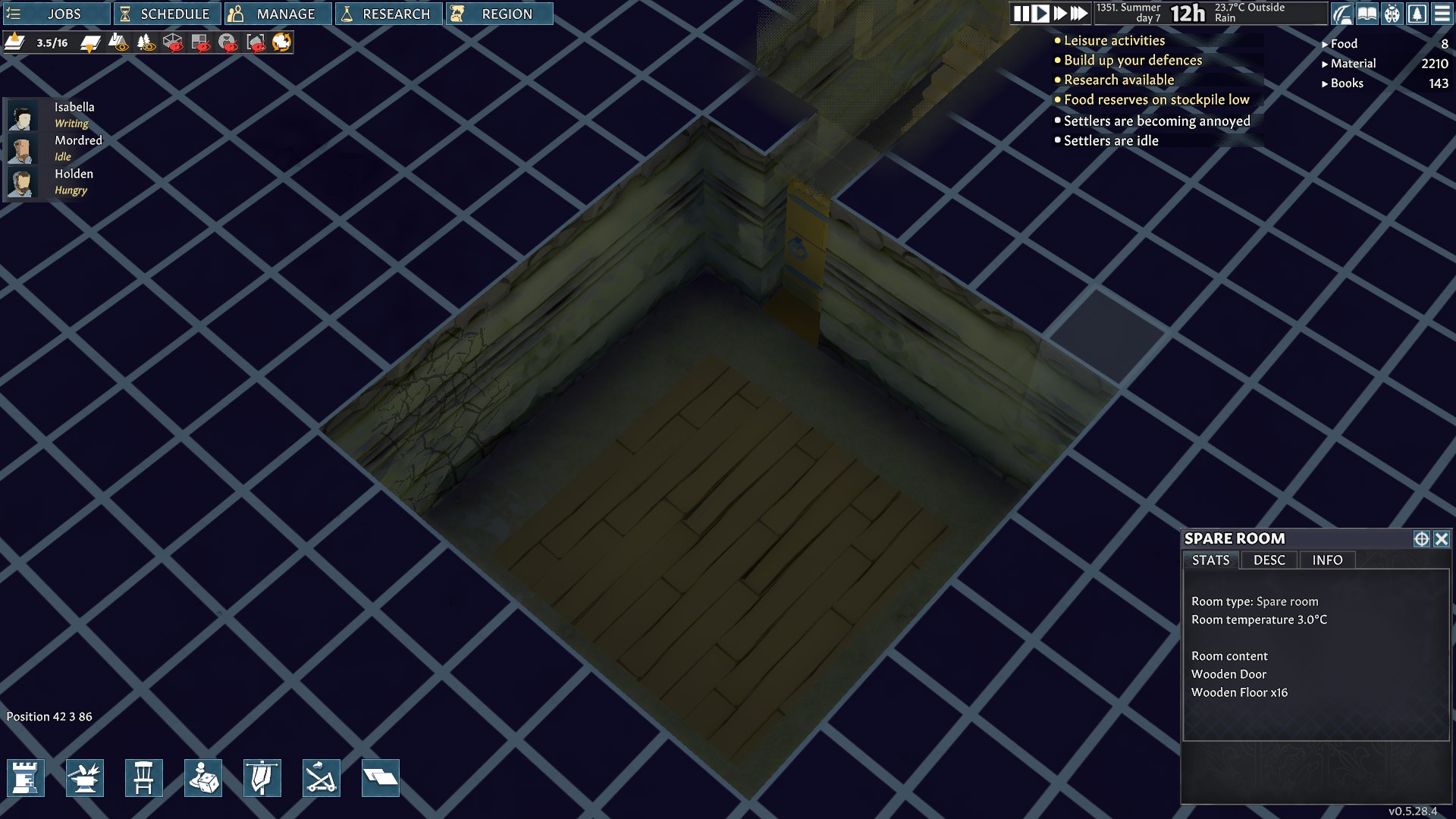going medieval холодная комната
Going Medieval Temperature guide for cold rooms
Follow us on Telegram, Facebook, Instagram, Twitter and so you will be aware of the best guides! Also, if you want to support us, just check out these deals on games from Amazon here!!
If you play Going Medieval, this guide is about the basics of how temperature works in this game. And how to create a room with a cold temperature, which will preserve your food forever.
Cold room in Going Medieval
Rule 1: What temperature are we going to?
For my experiment with piles of stew, I place them in the storage area around town.
Here is the result:
Rule 2: watch out for the ladder
If you make a ladder like this, it will be difficult for the temperature to drop when you dig, because it will average the temperature of each floor. The simple solution is to create a new room on the ground floor and separate it from the main staircase with a door.
Rule 3: The important thing is not how low the floor is, but what is above
Let’s look at more examples of what I did before explaining further.
As you can see, rooms A, B, and C are directly above each other and separated by a simple wooden floor. Whereas Room D is on the same floor as Room A and Room E is on the same floor as Room B.
You may notice that rooms D and E have a lower temperature than room C, even if they are on the top floor. Why? Because there is a patch of dirt on top to protect from the heat instead of three thin wooden floors, which is very logical. This can be explained further in my drawing below.
Rule 4: depth counts too
In the screenshot above, you can see that rooms B and C are on the same level, but the room temperature is not the same. The only difference is that room C has a longer corridor than room B, which means that it is further away from the heat source and therefore has a lower temperature.
Another example, I create three rooms on the same level as the sequence as in the screenshot above. You can see that each room has different temperatures, especially the deepest one.
So, we can conclude from this rule that, room temperature also counts from how far your room is from the heat source.
Rule 5: The size of the room is important
So I wonder what the temperature will be if I expand horizontally. So, I create two buildings with the same material, the same wooden floor, wall, door, and thatched roof. The only difference is its size. It turns out that the large one has a lower ambient temperature at 19,5 ° C, while the smaller one has 21,9 ° C. Therefore, the size of the room is important in some way.
Rule 6: Cold room on the ground, is it possible?
Yes. It is an earth pyramid that allows you to store a 3 × 3 square in the center. I am able to reduce the temperature from 22,6 ° C to 14,3 ° C with this method. If I keep adding wall and ceiling, the temperature will slowly drop later.
But as you can imagine how much time and resources you need to complete it, I think it is not worth the time and resources to do it. You can also make a room larger to reduce heat further, but it will also need more material to make the wall and ceiling.
Rule 7: My Best Practical Solutions
For any other scenario, just dig two floors into the ground like in the screenshot and create a room at the end of the staircase, you can get 4 ° C out of a 22.5 ° C sunny day.
If you still want to get a lower temperature, you can create a bigger room and remove the flooring around the room as shown in the screenshot above. Since those hardwood floors generated heat somehow, removing them will make the room cooler, but don’t forget that the food must be on the hardwood floor, so don’t put your food storage on the ground. With this method, I lowered the temperature to 3 ° C.
As you can see, by removing another outer layer of hardwood flooring, I am able to lower my temperature back to 0.6 ° C. So basically you just keep expanding the room without building the floor, the temperature will keep dropping.
Going Medieval Температурный режим для холодильных камер
Подпишитесь на нас в Telegram, Facebook, Instagram, Twitter и так вы будете в курсе лучших гидов! Кроме того, если вы хотите поддержать нас, просто ознакомьтесь с этими предложениями на Amazon здесь!
Если вы играете Going Medieval, это руководство посвящено основам работы температуры в этой игре. И как создать комнату с холодной температурой, которая сохранит вашу пищу навсегда.
Холодная комната в Going Medieval
Правило 1: Какую температуру мы собираемся?
Для моего эксперимента с кучами тушеного мяса я кладу их на склад в окрестностях города.
Вот результат:
Правило 2: берегитесь лестницы
Правило 3: Важно не то, насколько низок пол, а то, что выше
Давайте посмотрим на другие примеры того, что я сделал, прежде чем объяснять дальше.
Как видите, комнаты A, B и C расположены прямо друг над другом и разделены простым деревянным полом. В то время как комната D находится на том же этаже, что и комната A, а комната E находится на том же этаже, что и комната B.
Вы можете заметить, что в комнатах D и E температура ниже, чем в комнате C, даже если они находятся на верхнем этаже. Почему? Потому что для защиты от жары вместо трех тонких деревянных полов сверху есть пятно грязи, что очень логично. Это можно объяснить далее на моем рисунке ниже.
Правило 4: глубина тоже имеет значение
На скриншоте выше вы можете видеть, что комнаты B и C находятся на одном уровне, но комнатная температура не одинакова. Единственное отличие состоит в том, что в комнате C коридор длиннее, чем в комнате B, а это значит, что она находится дальше от источника тепла и, следовательно, имеет более низкую температуру.
Другой пример, я создаю три комнаты на том же уровне, что и последовательность, показанная на скриншоте выше. Вы можете видеть, что в каждой комнате разная температура, особенно в самой глубокой.
Итак, из этого правила мы можем сделать вывод, что комнатная температура также зависит от того, насколько далеко ваша комната находится от источника тепла.
Правило 5: Размер комнаты важен
Правило 6: Возможно ли холодное помещение на земле?
Да, это земная пирамида, которая позволяет разместить в центре квадрат 3 × 3. С помощью этого метода я могу снизить температуру с 22,6 ° C до 14,3 ° C. Если я продолжу добавлять стены и потолок, позже температура постепенно упадет.
Но поскольку вы можете себе представить, сколько времени и ресурсов вам нужно для его завершения, я думаю, что это не стоит времени и ресурсов. Вы также можете увеличить комнату, чтобы еще больше уменьшить тепло, но для стен и потолка потребуется больше материала.
Правило 7: Мои лучшие практические решения
Для любого другого сценария просто закопайте два этажа в землю, как на скриншоте, и создайте комнату в конце лестницы, вы можете получить 4 ° C из солнечного дня 22.5 ° C.
Если вы все же хотите получить более низкую температуру, вы можете создать комнату большего размера и удалить пол вокруг нее, как показано на скриншоте выше. Поскольку эти паркетные полы каким-то образом выделяли тепло, их удаление сделает комнату прохладнее, но не забывайте, что продукты должны находиться на паркетном полу, поэтому не ставьте хранилище продуктов на землю. Этим методом я снизил температуру до 3 ° C.
Как видите, удалив еще один внешний слой паркетного пола, я смог снизить температуру до 0.6 ° C. Таким образом, вы просто продолжаете расширять комнату, не накапливая пол, температура будет продолжать падать.
Основы холодной комнатной температуры в Going Medieval
В этом руководстве я опишу основные принципы работы температуры в этой игре. И как создать комнату с холодной температурой, в которой ваши блюда сохранятся навсегда в Going Medieval
Однако я не буду переходить к точной формуле расчета в этом руководстве. Я не буду приводить никаких математических уравнений или подробно описывать, как рассчитать каждый градус Цельсия.
Правило 1. На какую температуру мы рассчитываем?
Судя по моему эксперименту с Stew Piles, я помещаю их в зону складирования вокруг города.
Правило 2: берегитесь лестницы
Правило 3: важно не то, насколько низок этаж, а то, что над ним
Давайте посмотрим на другие примеры того, что я сделал, прежде чем объяснять дальше. Как видите, комнаты A, B и C находятся прямо друг над другом и отделены простым деревянным полом. В то время как комната D находится на том же этаже, что и комната A, а комната E находится на том же этаже, что и B. Вы можете заметить, что в комнатах D и E температура ниже, чем в комнатах C, даже если она находится на верхнем этаже. Почему? Потому что над ним для защиты от жары лежит кусок грязи, а не три тонких деревянных пола, что очень логично. Это можно объяснить более подробно на моем рисунке ниже.
Правило 4: Глубина тоже в счет
Итак, из этого правила мы можем сделать вывод, что комнатная температура также рассчитывается исходя из того, насколько далеко ваша комната находится от источника тепла.
Правило 5: Размер комнаты имеет значение
Затем мне интересно, какой будет температура, если я развернусь по горизонтали. Итак, я создаю два здания из одного материала, с одинаковым деревянным полом, стеной, дверью и соломенной крышей. Единственное отличие — это размер. Оказалось, что у большого устройства более низкая комнатная температура — 19,5 ° C, а у меньшего — 21,9 ° C. Поэтому размер комнаты как-то имеет значение.
Правило 6: Холодная комната над землей, возможно ли это?
Итак, из того, что мы узнали до сих пор, нам нужен кусок земли над комнатой, потому что он лучше, чем крыша и пол, чтобы защитить комнату от тепла, и нам нужна очень большая стена, чтобы сделать нашу кладовую глубже от солнца. И это то, что я до сих пор подхожу … Ага. Это пирамида из грязи, которая позволяет разместить в центре квадрат 3×3. С помощью этого метода мне удается снизить температуру с 22,6 ° C до 14,3 ° C. Если я продолжу добавлять стены и крышу, позже температура будет медленно падать.
Но как вы можете себе представить, сколько времени и ресурсов вам нужно, чтобы завершить это, что, я думаю, не стоит того времени и ресурсов, которые нужно делать. Кроме того, вы можете увеличить комнату, чтобы уменьшить количество тепла, но вам понадобится больше материала, чтобы сделать стены и крышу.
Правило 7: Мои лучшие практические решения
Для любого другого сценария просто выкопайте два этажа под землей, как на скриншоте, и создайте комнату в конце лестницы, я могу получить 4 ° C в солнечный день 22,5 ° C. Если вы каким-то образом все же хотите снизить температуру, вы можете создать комнату большего размера и убрать пол вокруг нее, как показано на скриншоте выше. Поскольку деревянный пол каким-то образом выделял тепло, их удаление приведет к тому, что в комнате станет прохладнее, но не забывайте, что ваша еда должна находиться на деревянном полу, поэтому не размещайте место для хранения продуктов на грязи. С помощью этого метода я снизил температуру до 3 ° C. Как видите, удаляя еще один внешний слой деревянного пола, мне удается снова снизить температуру до 0,6 ° C. Так что просто продолжайте расширять комнату, не накапливая пол, температура будет становиться все ниже.
Going Medieval – The Fundamental to Cold Room Temperature
However, I will not go to the exact calculation formula in this guide. I will not provide any mathematical equation or go in detail of how to calculate each degree Celsius.
This guide consist of seven parts, it take around 5 – 10 minutes to read, I hope you enjoy what I wrote and thank you for all your time 😀
Rule 1: What Temperature Are We Going For?
Short answer: 5°C and below.
From what my experiment with Stew Piles that I place them in the stockpile zone around the town.
Here is the result:
Rule 2: Watch Out Your Stair
Since the stair doesn’t separate rooms from each other, which mean if you dig the ground as I do in the screenshot below, it will count as one room, so this mean the lower floor will have the same temperature and the top floor.
If you make a stair like this, it will be difficult for the temperature to go down when you dig down, because it will average the temperature from every floor. The simple solution is to create a new room at the lower floor and separate it from the main stair with door.
Rule 3: What Important Isn’t How Low the Floor Is, But What It’s Above
You may think that the temperature is lower because you are at the lower floor. But the true is, what make your room temperature drop is what it is that stay above your room.
Let’s see more example of what I did before I explain furthermore.
As you can see that room A, B, and C, are directly above from each other and separate by a simple wooden floor. While room D is in the same floor as room A, and room E is in the same floor as B.
You may noticed that room D and E have lower temperature than room C even it is on the upper floor. Why? Because there is a chunk of dirt above it to protect the heat rather than three slim floors of wood, which is very logical. This can be explain more in my drawing below.
Rule 4: The Deep Is Also Count
By deep, I mean how long it is from the source of heat. The more faraway your storage room is, the more colder it is. This rule is heavily apply to the underground. Let’s see some more example:
In the screenshot above, you can see that both room B and C are on the same level but room temperature is not the same. The only different is that Room C has a longer corridor than Room B, which mean it is deeper from the source of heat, and thus has a lower temperature.
Another example, I create three rooms in the same level as sequence like in the screenshot above. You can see that each room have different temperatures especially the deepest one.
So, we can conclude from this rule that, the room temperature also count from how far your room is from the source of the heat.
Rule 5: Room Size Is Matter
While I experiment thing underground, I noticed something from the stair rule about expanding your room vertical and then the room temperature will be averaged from each floor.
Then, I wonder what the temperature will be if I expand horizontal. So, I create two building with the same material, same wooden floor, wall, door, and thatched roof. The only different is it size. Turn out the big one has lower room temperature at 19.5°C, while the smaller one has 21.9°C. Therefore, room size is matter somehow.
Rule 6: Cold Room Above Ground, Is It Possible?
Short Answer: Yes, but maybe not worth it.
So, from what we learn so far, we need a chunk of dirt above room because it is better than roof and floor in order to protect room from heat, and we need a very large wall to make our storage room deeper from the sun. And this is what I come up so far…
Yep. It is pyramid of dirt which allow you to store a 3×3 square in the center. I manage to reduce the temperature from 22.6°C to 14.3°C with this method. If I keep adding wall and roof, the temperature will slowly drop later.
But as you can imagine how much time and resource you need to complete it, which I think it isn’t worth the time and resource to do. Also, you can make a room bigger to reduce more heat, but you will need more material to make wall and roof also.
Rule 7: My Best Practical Solutions
So, in this last section, I will show you my best method to create the cold storage room. What I consider most is that these methods can be done in 1-2 day early game, with minimum resource needed, and can be done with any villagers you got.
For any other scenario, just dig two floor down the ground as in the screenshot and create a room at the end of the stair, I can get 4°C from 22.5°C sunny day.
If you somehow still want to get lower temperature, you can create bigger room and remove floor around the room as in the screenshot above. Since those wooden floor did generate a heat somehow, removing them will cause the room to be cooler, but don’t forget that your food need to be on the wooden floor, so don’t zone your food storage on dirt. With this method, I did lower my temperature to 3°C.
As you can see, by removing another outer layer of wooden floor, I manage to lower my temperature again to 0.6°C. So, basically just keep expand the room without building the floor, the temperature will keep getting lower.
Well, this is the end of my guide, I hope you like what I wrote, and thank you for your time.
Let’s go gaming. 😀
This is all about Going Medieval – The Fundamental to Cold Room Temperature; I hope you enjoy reading the Guide! If you feel like we should add more information or we forget/mistake, please let us know via commenting below, and thanks! See you soon!
Going medieval холодная комната
In this guide, I will describe the basic of how the temperature work in this game. And how to create a room with cold temperature, which will preserve your food forever.
However, I will not go to the exact calculation formula in this guide. I will not provide any mathematical equation or go in detail of how to calculate each degree Celsius.
Short answer: 5°C and below.
From what my experiment with Stew Piles that I place them in the stockpile zone around the town.
Here is the result:
Since the stair doesn’t separate rooms from each other, which mean if you dig the ground as I do in the screenshot below, it will count as one room, so this mean the lower floor will have the same temperature as the top floor.
If you make a stair like this, it will be a little more difficult for the temperature to go down when you dig down, because it will average the temperature from every floor. The simple solution is to create a new room at the lower floor and separate it from the main stair with a door.
You may think that the temperature is lower because you are at the lower floor. But the truth is, what make your room temperature drop is what it is that stay above your room.
Let’s see more example of what I did before I explain furthermore.
As you can see that room A, B, and C, are directly above from each other and separate by a simple wooden floor. While room D is in the same floor as room A, and room E is in the same floor as B.
You may noticed that room D and E have lower temperature than room C even it is on the upper floor. Why? Because there is a chunk of dirt above it to protect the heat rather than three slim floors of wood, which is very logical. This can be explain more in my drawing below.
I was surprise to find out about this at first, when you build the wooden floors in the room underground, it will generate some heat which you need to be considering when building cold room underground. Let’s see the example:
However, this rule doesn’t seem to be apply with the room above ground. As you can see in the above screenshot is that the room without floor in the left has 12.2°C, while the room with wooden floor in the right has only 12.7°C which is not change very much (it’s increase a little bit, because the outside temperature increase).
This is another surprise thing that I found out, every room have floor radius two more block away from the floor inside the wall. This may sound confusing, so let’s me show you another example photo.
From this photo, I build a room of 3×3 underground in the yellow line with wooden floor, and the blue line is the room radius. As you can see from the info box, they count every thing in room radius, so there are 10 wooden floors as in orange line, and 1 wooden door in the cross orange line with the room temperature of 1.1°C.
Another example, it is a 3×3 underground room in yellow line with wooden floor, and the blue line is the room radius. This time, the info box say there are 29 wooden floors because it’s count every floor in radius even it is outside the room. In the previous rule, we knew that the underground wooden floor generate heat, and with these 29 wooden floors, the room temperature suddenly jump to 7.4°C, so better watch out.
Since, the floor doesn’t generate heat above ground. So, you don’t need to worry about this rule above ground. I still don’t know why this rule exist, it look like the radius only count wall and floor as part of the room, but not the furniture. So, you can’t create a Library with book shelf on the outside of the room.
While I experiment thing underground, I noticed something from the stair rule about expanding your room vertical and then the room temperature will be averaged from each floor.
Then, I wonder what the temperature will be if I expand horizontal. So, I create two building with the same material, same wooden floor, wall, door, and thatched roof. The only different is it size. Turn out the big one has lower room temperature at 19.5°C, while the smaller one has 21.9°C. Therefore, room size is matter somehow.
This is also true, with the underground room. As you can see, room A which has a bigger room size also colder than room B.
Short Answer: Yes, but maybe not worth it.
So, from what we learn so far, we need a chunk of dirt above room because it is better than roof and floor in order to protect room from heat, and we need a very large wall to make our storage room deeper from the sun. And this is what I come up so far.
Yep. It is pyramid of dirt which allow you to store a 3×3 square in the center. I manage to reduce the temperature from 22.6°C to 14.3°C with this method. If I keep adding wall and roof, the temperature will slowly drop later.
But as you can imagine how much time and resource you need to complete it, which I think it isn’t worth the time and resource to do. Also, you can make a room bigger to reduce more heat, but you will need more material to make wall and roof also.
So, in this last section, I will show you my best method to create the cold storage room. What I consider most is that these methods can be done in 1-2 day early game, with minimum resource needed, and can be done with any villagers you got.
For any other scenario, just dig two floor down the ground as in the screenshot and create a room at the end of the stair, I can get 4°C from 22.5°C sunny day.
If you somehow still want to get lower temperature, you can create bigger room and remove floor around the room as in the screenshot above. Since those wooden floor did generate a heat somehow, removing them will cause the room to be cooler, but don’t forget that your food need to be on the wooden floor, so don’t zone your food storage on dirt. With this method, I did lower my temperature to 3°C.
As you can see, by removing another outer layer of wooden floor, I manage to lower my temperature again to 0.6°C. So, basically just keep expand the room without building the floor, the temperature will keep getting lower.
This is my current design for cold storage, which I decide to separate room into many parts as a cooling unit and storage unit. But if you start to understand a concept of temperature and get comfort with your building skill, you can design it anyway you like as long as it work!
Well, this is the end of my guide, I hope you like what I wrote, and thank you for your time.
Let’s go gaming. 😀
I put this topic as an extra because there is noting relate to the temperature rule, but since there are a few people asking about it, so I decide to put it here : )
In this game, there is a thing call stability, which act as a gravity force, so you can’t build anything that defy gravity law like floating castle as in Minecraft. Let’s see how stability work in the next picture.
Stability rule is simple, it’s start with 4, and when it hit 0, the object is destroyed. Once you build any object, it will use the same stability value as the object directly below it where it place. If the object below it is absent, it will use the highest stability value from the object next to it in four direction (north, east, south, west) and minus by 1. If there is still none, this object will not be able to build.
So, with the stability rule in mind, I usually design my underground cold storage room expand the other way from my building. By doing this, I don’t need to worry about my underground room will collapse my castle if I expand too wide. If you didn’t plan to create a massive labyrinth underground, and you just need a room to store food, I recommend this method for you.
If, you really want to have an underground room directly below your building, but you are too lazy to design something complicate. I recommend you to create the pile foundation like in real life construction business. Each with 2 blocks away from each other this will guarantee that you will always have enough stability to create floor on top no matter how big your room is and no matter which direction you expand. The downsize for this design is, there will be a lot of pillar in you room and blocking a lot of space for furniture, so you need to be a little bit clever in interior design instead.
The reason why these pile foundation is a recommend method, because it is the best way to sustain stability value. From the above image, you can see that the layout in the middle is very messy to deal with, you barely have any stability enough to build anything in the top floor. That why I recommend to create a pillar in one line as in the left layout. Of course, you can try any other combination that suits your play style. Six is probably the largest space away from one pillar with another, you can create a big room space with this. But don’t forget to keep your eye on stability.
In the end, this is only just a guide, you can mix and match my idea with your to create any great structure you wish. Have fun! 😀
